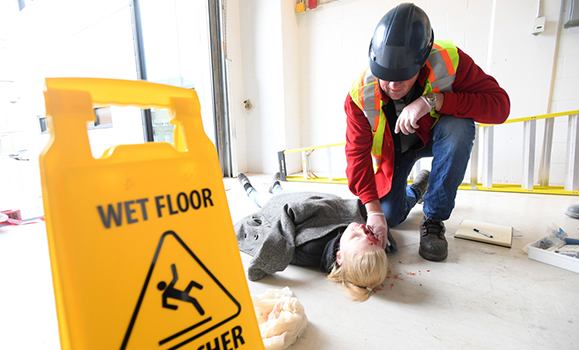Editor's note: The following story contains photographs of mock accident scenes with make-up effects, including fake blood.
The blood-curdling screams ripped through the unseasonably warm Thursday morning air, as passersby on LeMarchant Street stopped to catch a glimpse at what had transpired at DalŌĆÖs Mona Campbell Building.
Inside the open loading bay, a young woman was lying on the cold concrete floor, covered in blood. A ladder was on the ground beside her. Did she fall? Was she struck? As she clutched her face, a crew of first responders tended to her while awaiting an ambulance, at the same time starting to take steps to figure what the heck had just happened.
Incredibly, herŌĆÖs werenŌĆÖt the only screams in the Mona Campbell Building that morning. Almost at the exact same time, another group of responders arrived in the buildingŌĆÖs basement to the scene of what appeared to be some sort of chemical burn. A custodian shrieked as her supervisor tended to her scarred, inflamed face, panicking over what to do as the rest of the accident investigation team arrived on the scene.
Thankfully, the gory bits were just makeup, and the ŌĆ£victims,ŌĆØ ŌĆ£supervisorsŌĆØ and ŌĆ£witnessesŌĆØ just actors: students from DalŌĆÖs Fountain School of Performing Arts, in fact, who were helping bring the simulation to life. The responders were students themselves, from the College of Continuing Education, completing their ŌĆ£final examinationŌĆØ in the advanced-level Accident Investigation course.
 Student actor Meg Fenchak is tended to after her "accident." ╠²
Student actor Meg Fenchak is tended to after her "accident." ╠²
Solving the puzzle
Part of the College of Continuing EducationŌĆÖs Occupational Health and Safety (OHS) Management certificate program, the four-day Accident Investigation course is typically taken by professionals working in the field, exposing them to the background, understanding and methods needed to conduct a thorough and effective investigation of a workplace accident.
ŌĆ£If you donŌĆÖt dig down to the root cause of an accident, then you canŌĆÖt stop it from happening again,ŌĆØ said Vince Garnier, the courseŌĆÖs instructor. ŌĆ£So we teach a lot of accident theory before transitioning to investigation methodology: how to approach a scene, caring for the injured worker, understanding what is evidence and what is not.ŌĆØ
Garnier has more than 34 years of experience in the field, covering both law enforcement and OHS public policy and regulatory enforcement. HeŌĆÖs hired by the College of Continuing Education to teach the Accident Investigation course, typically offered twice a year.
ŌĆ£ItŌĆÖs almost like a puzzle,ŌĆØ says Garnier, pointing around to some of the various pieces of evidence in the loading bay scenario. ŌĆ£You have a 500-piece puzzle: you have to find all the pieces, put them together, and then you have the full picture.ŌĆØ
Downstairs, outside the bathroom where the chemical burn scenario was underway, Steve Job was monitoring the cordoned-off scene. A student in the Accident Investigation course, heŌĆÖs nearing the end of a career in the military and looking to get into OHS work. This is the last course needed to complete his OHS Management certificate.
ŌĆ£You learn a lot,ŌĆØ he said, highlighting the s

